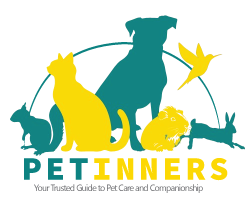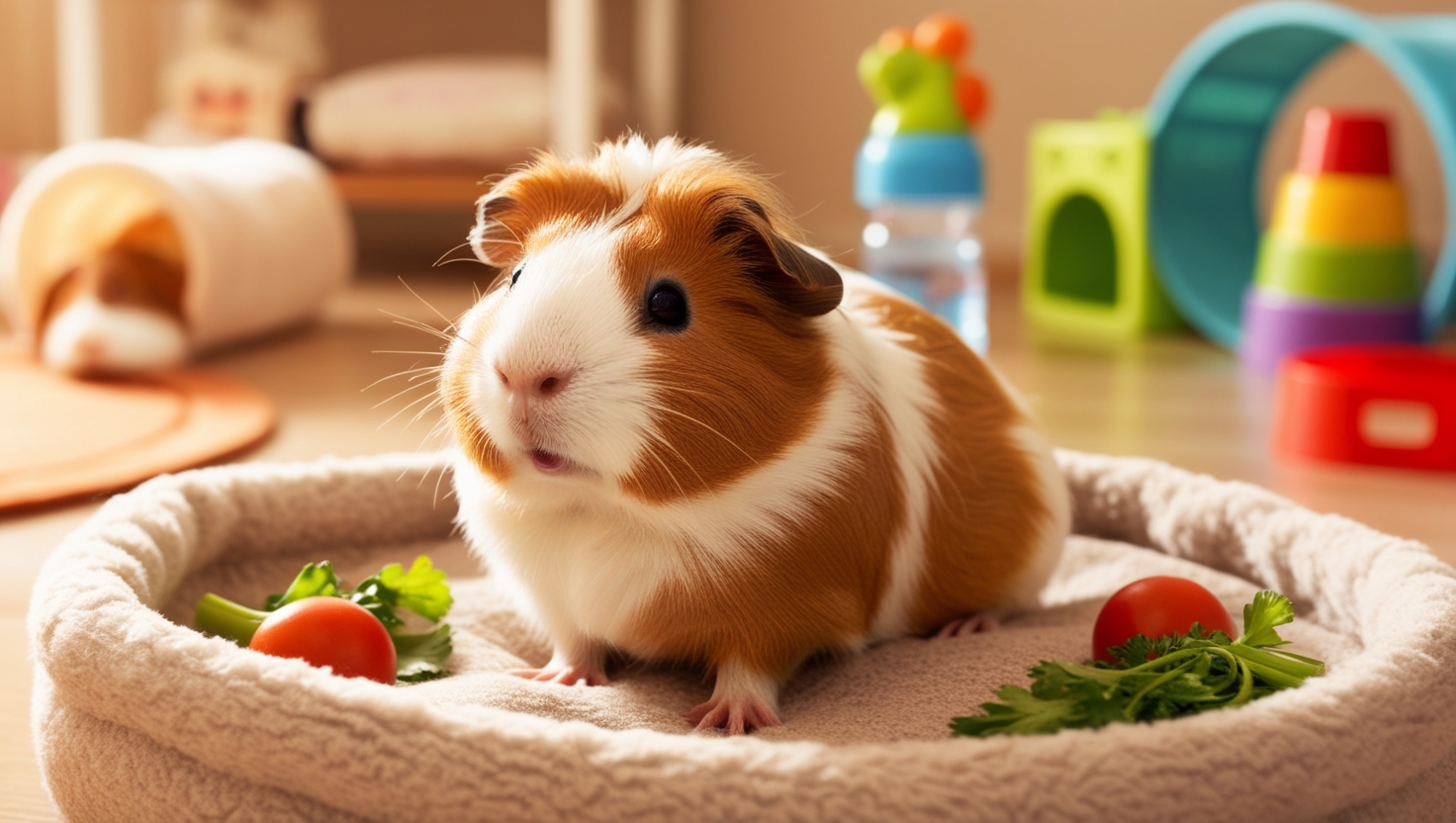Transform your guinea pig’s life with enrichment activities like foraging, tunnels, and safe social interactions. Prioritize their natural instincts and well-being by creating a secure, stimulating habitat, promoting both happiness and health every day.

Introduction
The goal of environmental enrichment for guinea pigs is to maximize their well-being by increasing both mental and physical stimulation. As a species, Cavia porcellus, commonly known as guinea pigs, are highly social and generally docile, making them an ideal pet. To ensure they lead the most fulfilling lives possible, it’s crucial to promote positive behavior by providing activities that engage their natural instincts. Hiding areas and food treats are simple yet important components of enrichment that can reduce frustration, boredom, and loneliness while increasing overall happiness.
An important aspect of caring for guinea pigs is social housing. Being social animals, they thrive when housed with others, as it mirrors their natural behavior. Stimulating their environment by including toys and tunnels can help keep them mentally and physically active. Additionally, creating a healthy habitat that encourages their natural behaviors like foraging and hiding is essential for their physical health and emotional well-being. This approach can also help reduce their neophobic tendencies, as guinea pigs are often fearful of novelty or unfamiliar objects.
In my experience, keeping guinea pigs mentally and physically stimulated requires creativity and careful planning. Offering a range of enriching activities tailored to their needs not only enhances their quality of life but also helps to ensure they are able to thrive in a well-rounded environment. By sharing ideas and experiences, we can further dive into the benefits of a rich, stimulating life for these gentle creatures, helping them lead happy, healthy lives.
What Is Guinea Pig Enrichment?
For well-rounded enrichment, guinea pigs need both physical exercise and mental exercise. You can encourage exploring by introducing novel objects or changing their home environment to keep them curious. Regular interactions with their human family also help build bonds and provide emotional stimulation. Additionally, training your guinea pig with gentle commands or simple food-based rewards adds another layer of activity. Incorporating auditory stimulation like different sounds or olfactory experiences with new scents can engage their senses in ways that mimic their natural instincts while manipulating objects and navigating new environments keeps them physically active.
Understanding Guinea Pig Enrichment
Creating a fascinating environment for guinea pigs means using knowledge of their biology, anatomy, and natural behavior to design a space where they can thrive. Enrichment is all about improving the quality of their lives by giving them choice and control over how they interact with their surroundings. For example, offering tunnels or hideouts allows them to feel safe, mimicking their natural prey instincts. It’s important to engage them with appropriate challenges that match their abilities and prevent frustration. According to experts like The Shape of Enrichment Inc., enrichment can be broken into five main categories, each with different applications and often overlapping, creating a well-rounded framework for captive or domestic animals.
The Benefits Of Guinea Pig Enrichment
Providing enrichment for your guinea pig is essential to prevent obesity and other health problems by encouraging them to stay active. Offering toys, space to roam, and plenty of hiding places gives them the opportunities to move and explore. For example, a spacious enclosure where they can play, run, and jump helps them engage in their natural behaviors like foraging. Increased activity reduces the risks that come with a sedentary lifestyle, making it an important part of keeping your guinea pig happy and healthy.
In addition to the physical benefits, mental stimulation is just as crucial. Enrichment helps prevent boredom and even depression, as guinea pigs are intelligent animals that I need to stay mentally engaged. Keeping them active also helps reduce stress and prevents common behavioral issues, like chewing on cage bars, which can worsen and lead to fallouts with cage mates. Ensuring they feel safe and secure is key since guinea pigs are prey animals by nature.
How To Enrich Your Guinea Pig’s Life
Providing chew toys made from safe materials is essential to allow guinea pigs to chew and gnaw, which helps keep their constantly growing teeth at a healthy length. Additionally, chewing can provide mental stimulation and help prevent boredom. Guinea pigs are naturally curious and love to explore, so providing tunnels and hideaways offers them hours of entertainment. You can also introduce balls or rolling toys for them to play with and move around. Some guinea pigs even enjoy pushing a ball with their noses or paws, and adding puzzles or interactive toys will help keep their minds engaged and active.
Social Enrichment For Guinea Pigs
Benefits Of Guinea Pig Companionship
Guinea pigs are highly social animals and thrive when they have the opportunity to live with another guinea pig. It’s important to carefully introduce them to each other in a spacious enclosure where they can comfortably share space and interact.

When they spend time together, they enjoy playing and engaging in activities like grooming and even training. To ensure they stay happy and mentally stimulated, it’s essential to provide interactive toys, such as play tubes and balls, to encourage natural social behaviors.
Socialization And Its Role In Well-Being
When guinea pigs socialize, it’s an important aspect of their care that brings numerous benefits, including improved physical health and mental stimulation. They are sociable animals that have evolved to live in groups for safety and companionship. In the wild, this behavior helps them feel more confident in detecting danger. At home, guinea pigs often display bonded behaviors, such as lying, eating, and even talking to each other. They may also huddle together for body heat when the temperature drops, making it a good idea to keep 2 or more females or a neutered male in the same space.
Introducing And Pairing Guinea Pigs
For those considering adopting rescues or looking to rehome singles, introducing adult guinea pigs can be one of the easiest pairings, especially if they are already bonded. Watching them form a friendship and interact is a rewarding experience. Whether it’s direct or indirect contact, these guinea pigs need some form of social interaction, as singly housed guinea pigs can become lonely and stressed.
Challenges And Space Requirements For Group Housing
Potential Issues With Group Housing
Of course, there are some drawbacks to group housing. You must watch for unwanted behaviors like aggression or even unexpected pregnancies if a male hasn’t been neutered. It’s essential to take steps to avoid these issues, such as desexing the guinea pigs and providing ample space. If any signs of fighting appear, particularly if one guinea pig is an aggressor, it’s best to separate them immediately and, if needed, consult Vet Services.
Creating The Perfect Environment
For guinea pigs to share their space successfully, the cage size should be large enough, with a minimum of 7.5 square feet for two guinea pigs and 10.5 square feet for larger groups. The cage should have a solid bottom to prevent hurting their feet, as wire flooring can cause injuries. Make sure their bedding is soft and absorbent, such as paper-based materials or fleece liners, and always avoid cedar or pine, as the oils in these can be harmful. With a little creativity and effort, you can create the perfect social environment for your guinea pigs to feel happy and safe.
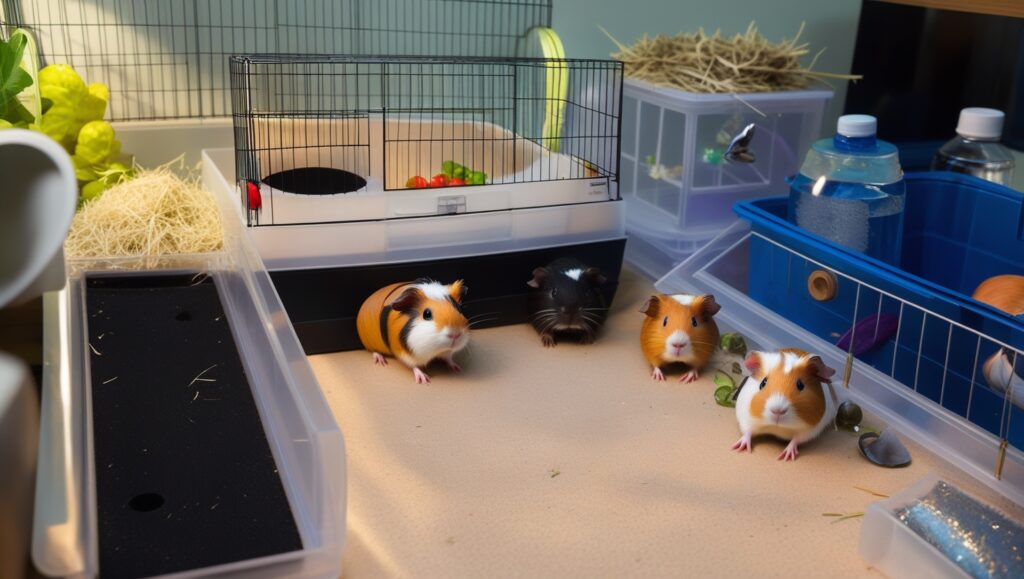
Sensory Enrichment For Guinea Pigs
Sensory enrichment can greatly enhance your guinea pig’s experience by engaging their sight, hearing, smell, and touch. For example, providing them with a room view or playing soft background noises like audio recordings of rain or forest sounds can help improve their welfare. However, it’s important to exercise caution, as guinea pigs can become visibly stressed by loud sounds or certain images. Avoid placing their enclosure in the middle of a busy family room, and ensure they have the ability to retreat to a private area when there are too many activities going on around them.
Environmental Enrichment For Guinea Pigs
Environmental enrichment is crucial for keeping guinea pigs happy and healthy. These social animals thrive in a pair-housed or social group setting, and even if they are in a single housing, they should have visual or olfactory contact with other guinea pigs to avoid isolation stress. Because guinea pigs can be neophobic, or fearful of novelty, it’s important to introduce new enrichments and structures carefully and gradually. For example, rearranging familiar items in their cage or offering new foods like fresh fruit and vegetables can enrich their lives, but changes should be made slowly to avoid stress.
To meet their nutritional requirements, guinea pigs need a diet rich in vitamin C, as they cannot synthesize themselves. Including hay, hard pellets, and wood blocks for chewing helps prevent overgrowth of their teeth. Offering food enrichment that encourages natural foraging and grazing behaviors can also reduce the risk of stereotypies, such as trichophagia (compulsive hair-eating). Providing a diverse home environment with items like cardboard tubes and softwood blocks for them to gnaw on ensures they stay physically and mentally stimulated, which promotes low anxiety and positive affect, often shown by behaviors like popcorning.
Foraging Opportunities
Creating foraging opportunities for your guinea pig is a great way to encourage their natural behavior. In the wild, guinea pigs spend up to 80% of their day feeding, and we can replicate this by scattering food around their enclosure. Using a foraging tray or hiding small amounts of food in various places allows them to use their sense of smell to search and explore, which keeps them mentally stimulated. Adding puzzle toys can make it even more rewarding, turning the process into a fun game where they get to find their food.
To keep things interesting and engaging, mix in different materials like chew toys, cardboard boxes, and hay racks that guinea pigs can manipulate and sort through. This mimics the natural foraging behaviors they would display in the wild. It’s important to replace and refill these accessories regularly to prevent boredom. Also, clean up any uneaten food and offer fresh options daily to avoid spoilt or harmful food in their environment.
You can get creative with ideas to implement more challenging foraging activities by using things like wooden blocks, recycled paper, or even an open sand pit filled with safe materials. For instance, placing food at their head height in a framed feeding rack can test their dexterity and add a new layer of fun to the routine. These small but effective steps help ensure that your guinea pig remains active, preventing problems like weight loss or stereotypic behaviors like circling or biting at wires.
Food Enrichment For Guinea Pigs
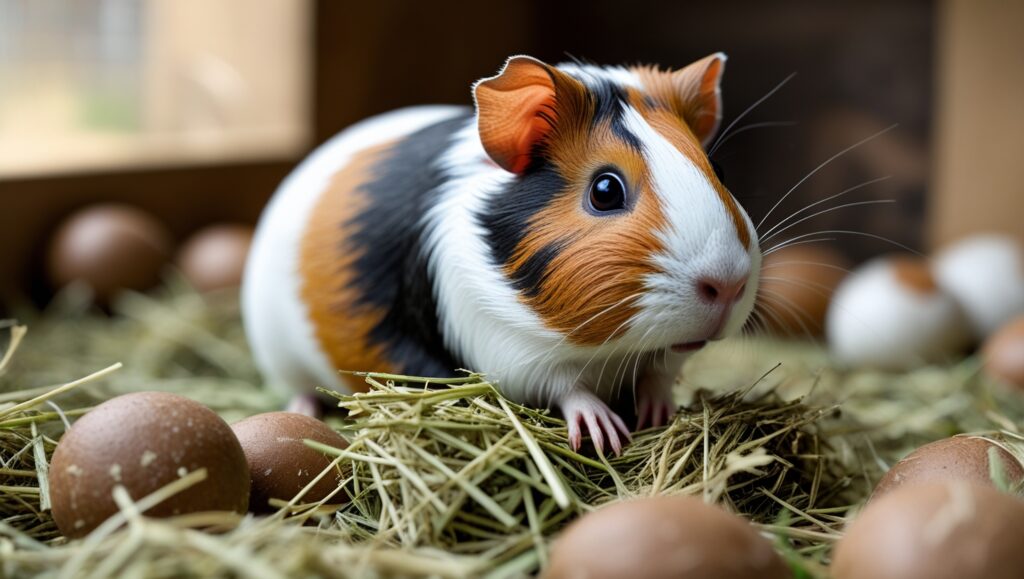
Mimicking Natural Foraging Behavior
Guinea pigs are natural foragers, spending up to 80% of their waking hours munching and searching for food. To keep them mentally and physically stimulated, it’s important to provide food enrichment that mimics their natural behavior. Their diet should be mostly hay-based, as this supports their teeth and digestive systems. Offering unlimited Timothy hay is essential for their dental health and fiber intake. Adding pellets and fresh produce like apples, carrots, and lettuce leaves helps diversify their diet and ensures they get the vitamin C they need, as guinea pigs cannot produce this vitamin on their own.
Engaging Feeding Methods
To make feeding more engaging, try scattering fresh produce in their housing or hiding it in creative ways like paper tubes, hay balls, or even cardboard tubes. Placing food in low hay racks or inside paper bags with the handles cut off encourages their natural foraging and burrowing behavior. By doing this, you not only provide physical activity but also stimulate their senses as they locate and eat their food, which reduces boredom and stereotypic behaviors like over-grooming or chewing on cage bars.
Treats And Balanced Feeding
Treats can be provided about 3 times a week, including options like bell peppers, cucumber, and fresh herbs such as cilantro or parsley. These should be given in small quantities, and avoid overfeeding sugary fruits, like berries, as they can be harmful. Always make sure to remove uneaten food daily to prevent contamination and ensure they get the right amount of nutrients. While fresh water is a must, make sure their water bottle is always clean and free from contamination.
Avoiding Unhealthy Foods
To maintain a balanced diet, seeds, and dried fruits should be avoided due to their high sugar content and unsuitability for a hay-based diet. Instead, focus on healthy greens, vegetables, and occasional treats scattered in their enclosure to keep them happy and mentally stimulated.
Benefits Of Food Enrichment
By offering a variety of food enrichment methods, you promote exercise, and better brain stimulation, and ensure they exhibit normal species-specific behavior in guinea pigs. This approach prevents mental dullness, reduces aggression, and ensures a healthier and happier pet.
Housing Enrichment For Guinea Pigs
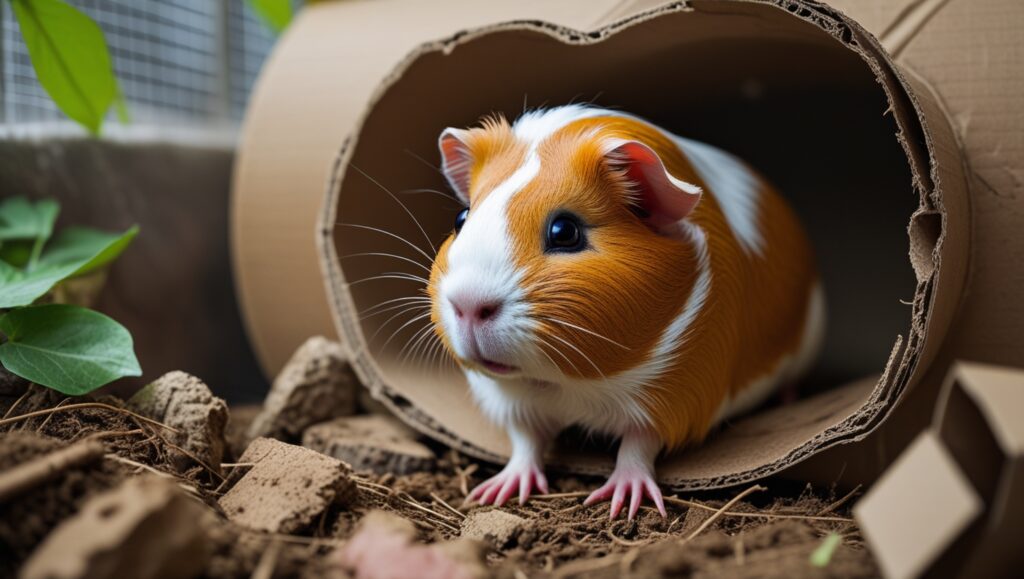
Providing Safe And Enriching Spaces
Creating the right housing enrichment for guinea pigs is essential to keep them happy, healthy, and active. Guinea pigs are prey species, which means they naturally avoid open spaces where they feel exposed and vulnerable. In the wild, they typically hide in undergrowth or cover to stay safe while exploring their surroundings. Providing them with hiding places, like tunnels, pipes, and cardboard boxes, allows them to feel confident and safe while moving around their enclosure.
Catering To Natural Behaviors
Since guinea pigs are low to the ground and fairly agile, their housing should cater to these locomotory behaviours. Offering steep ramps for access to hides and tunnels mimics their natural environment. Rotating novel items like hay piles, plastic beds, and curious objects will keep them mentally stimulated. These items not only serve as physical enrichment but also help create an interactive environment where guinea pigs can display their natural running and playing behaviors.
Protection From Predators
Guinea pigs need a secure place where they can feel protected from potential predators, such as foxes, cats, dogs, and birds of prey. Placing multiple shelters, pipes, and burrows in their enclosure ensures that they have enough places to hide and rest. It’s also important that these hiding places are made of safe materials, avoiding anything with synthetic components that could cause harm if ingested. Instead, opt for cotton or other natural fibres to prevent gut obstructions.
Managing Multiple Guinea Pigs
If you have multiple guinea pigs, be sure to provide enough space to reduce the chances of guarding and aggression. Introducing new guinea pigs slowly can help prevent stress and ensure a harmonious environment. Their cages should be made of wire mesh or transparent plastic to allow for good ventilation and easy interaction with handlers, but it’s crucial to avoid open surfaces where guinea pigs may feel unsheltered and more prone to stress. Providing a sheltered area within the enclosure can make them feel more secure.
Ensuring Proper Cage Design
The enclosure should be spacious, with a minimum of 7.5 square feet for two guinea pigs and 10.5 square feet for larger groups. Cages with solid floors are preferred, as wire flooring can hurt their feet and cause discomfort. It’s also important to avoid multi-level cages, as guinea pigs can easily fall and injure themselves. Instead, focus on providing soft bedding made from paper-based products, fleece liners, or aspen shavings, while avoiding cedar and pine, which can release harmful oils.
Maintaining Optimal Climate And Lighting
In terms of climate, guinea pigs are sensitive to extreme temperatures. They should be housed in an area with a temperature range between 15-21°C to avoid heat stroke or discomfort. Ventilation is key in maintaining a well-regulated environment. A 12-hour day-night cycle helps guinea pigs follow their natural circadian rhythms, as they are more active during the early morning and evening. Ensuring their living space is softly lit during the day and dark at night mimics their natural habitat.
Preventing Health Issues
Finally, to prevent health issues like pressure sores or pododermatitis (inflammation of the feet), make sure the cage size is large enough for them to move freely. Guinea pigs should be housed on solid floors with dust-free substrate, like wood chips or fleece. For adult guinea pigs weighing over 1kg, providing a minimum enclosure size of 2500cm² is recommended, according to EU standards.
By following these guidelines, you can create a safe, enriching, and comfortable environment where your guinea pigs can thrive.
Providing Hiding Areas For Guinea Pigs
Understanding Guinea Pigs’ Natural Instincts
Guinea pigs are naturally cautious animals, descended from the wild cavy or Cavia aperea, a medium-sized rodent that inhabits humid grassland habitats in South America. In the wild, they rely on dense high vegetation and thick ground cover to stay hidden from predators. As a result, it’s essential to provide hiding areas in their enclosures to help them feel secure. Polycarbonate or cardboard huts and tubes offer great options for your guinea pigs to retreat into when they feel vulnerable or need a quiet place to rest.

Enrichment Through Hiding Spaces
Whether you are caring for a single guinea pig or introducing groups of guinea pigs, having plenty of hiding places can enrich their lives and reduce stress. Bonded pairs like a neutered male and a female will enjoy exploring together, while two un-neutered males might need separate spaces to avoid conflict. If you are adopting rescues or trying to rehome singles, providing these shelters helps ease their transition into new homes. Watching your guinea pigs interact in a safe, enriched environment is not only rewarding but also keeps them happy and healthy.
Mimicking Natural Behaviors
In the wild, guinea pigs use their surroundings to communicate and stay safe from predators. They often dig burrows or use natural tunnels in thick vegetation as sleeping and resting sites. In captivity, you can mimic this behavior by offering them different huts and tunnels to explore and hide in. This is especially important for females and males when living together in small groups, as it helps them establish territories and reduces stress.
Supporting Crepuscular Activity
Guinea pigs are most active during dusk and dawn, as they have evolved to be crepuscular animals. During these times, they are likely to seek out shelter to feel secure, especially when they sense a potential predator. Providing several hiding areas allows them to enjoy their natural behaviors, such as scent marking and communicating with soft squeaks and whistles while feeling safe in their surroundings.
Maintaining A Clean And Hygienic Environment
To keep your guinea pig happy and healthy, it’s important to regularly clean their cage. Once a week, make sure you’re removing soiled bedding and wiping down surfaces with a pet-safe cleaning solution. A good option is a mix of white vinegar and diluted water in a spray bottle, which is effective and safe for cleaning guinea pig cages. You can also purchase cleaning solutions from a pet store that are specifically designed for small animal habitats.
In addition to weekly deep cleaning, spot-cleaning daily will help maintain a fresh environment for your guinea pig. Sanitization is key—make sure to use disinfectants to clean cage accessories, and always rinse thoroughly to remove any residues that could cause harm. Providing a healthy, enriching environment for your guinea pig involves more than just cleanliness—it also requires proper housing, a balanced diet, and plenty of mental and physical stimulation. By following these steps, you can ensure your guinea pig lives a happy and fulfilling life.
Regular Health Care And Grooming
Grooming is an essential part of keeping your guinea pig healthy. Long-haired guinea pigs require regular grooming to prevent matting, while short-haired breeds need only occasional brushing to remove loose fur. It’s also important to regularly trim their nails to prevent overgrowth, which can cause discomfort or even injury. Along with grooming, you should always monitor their health by keeping an eye out for signs of illness, such as changes in eating habits, lethargy, or abnormal discharge. Regular veterinary check-ups are also important to ensure your guinea pig stays healthy and happy.
Avoiding Harmful Enrichment For Guinea Pigs
While guinea pigs are fascinating to watch when they are in the right environment, it’s important to avoid certain types of enrichment that can be harmful. Unlike other species, guinea pigs are not built for jumping or navigating complex obstacle courses, as these activities can cause harm to their bodies. Their anatomy is delicate, and too much strain on their bones and joints can increase the risk of arthritis. Experts, like those at Shape of Enrichment Inc., advise caution when designing ramps or other structures, ensuring they are gentle and safe.
Instead of pushing your guinea pigs beyond their natural abilities, focus on providing a stimulating but safe environment that promotes their positive welfare. Giving them the choice and control to engage in activities that mimic their natural behavior, like exploring tunnels or foraging, ensures they stay happy and healthy. Always consider their biology and take veterinary advice before introducing any new enrichment that could have a negative impact on their well-being.
Conclusion
In conclusion, providing effective enrichment for guinea pigs involves addressing their physical, mental, and social needs by creating a safe, stimulating, and interactive environment. This includes incorporating activities that mimic their natural behaviors, such as foraging, exploring tunnels, and hiding while ensuring a balanced diet rich in vitamin C and opportunities for exercise. Social housing is vital, as guinea pigs thrive in companionship, and careful introductions can prevent conflicts in group settings. Sensory stimulation, proper housing design, and regular health care further support their well-being, while avoiding harmful activities that strain their delicate anatomy is crucial. By combining these elements thoughtfully, owners can ensure their guinea pigs lead healthy, happy, and fulfilling lives.
FAQ
What is guinea pig enrichment?
Guinea pigs are curious creatures that spend a lot of their day moving around and exploring their environment. Providing them with a variety of choices helps keep them mentally stimulated and happy. One way to enrich their lives is by offering different items like a plastic tub or a tunnel where they can hide or rest. Guinea pigs love to feel safe, so having a shelter on the ground floor for them to retreat into is important. Placing hay near their eating area encourages foraging, as they naturally enjoy nibbling from the floor while feeling secure in their hide. This setup not only keeps them active but also gives them a cozy space to call home.
What is the mental enrichment of guinea pigs?
To keep your guinea pigs happy and healthy, it’s important to create cozy hideaways like small houses or tunnels made from pet-safe materials such as wood, cardboard, or fleece. These hideys offer them a place to retreat where they feel safe and secure. In my experience, regularly changing the cage setup by adding new chew toys and foraging toys keeps them entertained. Make sure to rotate the toys so they don’t get bored, and remember that social interaction is just as important as their physical environment for a balanced and enriching life.
How do you introduce a guinea pig?
When setting up housing for your guinea pigs It’s important to consider how they interact with each other. If you have multiple guinea pigs, you can place their hutch or cages next to one another with a barrier in between so they can see and smell each other safely. This allows them to socialize without conflict, especially in a neutral space where they don’t feel territorial. A setup like this encourages natural behavior while giving them room to run and explore comfortably.
What is nutritional enrichment for guinea pigs?
To add excitement to your guinea pig’s daily routine, try offering their fortified food in more enriching ways. Instead of just placing the food in a food dish, scatter it in different parts of their habitat. Hiding food under a pile of hay or in a hide can encourage natural foraging behavior, making mealtime more of a challenge and engaging them spatially. This approach keeps them mentally active, giving them a reason to explore and think about how to get their favorite treats.
Kindly note: The content shared in this blog is gathered from online sources, some of which may not be verified. For accurate guidance on caring for your guinea pig, it is recommended to seek advice from a qualified veterinarian.
